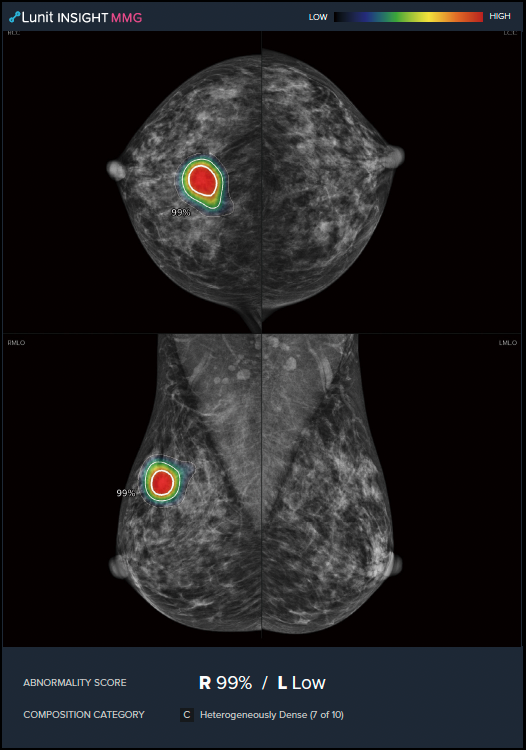Solución de IA para mamografía LunitMMG
Lunit INSIGHT MMG detects breast cancer on mammograms with 96% accuracy.
Detected Location: The location information of detected breast cancer in the form of heatmap and outlines
Abnormality Score: An abnormality score for each side of the breast, which reflects the AI’s calculation of the actual presence of the detected breast cancer
Density Assessment: Assessment of breast density, categorized into four types
What are the major benefits of using it?
01 Detect more breast cancers
The combination of first-reader radiologists and Lunit AI detects more breast cancers, than not only the first-reader and second-reader radiologists but also the double reading by radiologists.
Health check-up centers
Community hospitals and clinics
Radiology departments
02 Fast triage of normal cases
According to the abnormality scores generated by AI, radiologists can successfully triage up to 60% of the entire cases without human interpretation, which can reduce their workload by more than half in mammogram interpretation.
Health check-up centers
Imaging clinics
Teleradiology centers
03 Improved reading performance of general radiologists
General radiologists can use the AI analysis results to improve their reading performance, at a level up to that of breast specialists.
Health check-up centers
Community hospitals and clinics
Radiology departments
04 Early diagnosis of breast cancer
Radiologists can detect T1 and node-negative breast cancer with 91% and 87% accuracy, respectively.
Health check-up centers
Community hospitals and clinics
Radiology departments
05 Support for decision-making on BI-RADS 3 and 4 cases
For difficult cases classified as BI-RADS 3 or 4, radiologists can compare their reading result and decide with confidence for additional exams such as ultrasound and biopsy
Health check-up centers
Community hospitals and clinics
Radiology departments
06 Improved diagnostic accuracy for dense breasts
Radiologists can improve their diagnostic accuracy for dense and fatty breasts by up to 9% and 22%, respectively.
Health check-up centers
Community hospitals and clinics
Radiology departments




 Edificio Torre Europa,
Edificio Torre Europa,


